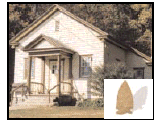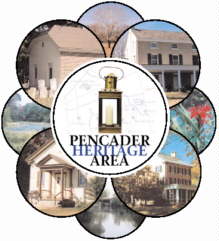 Much has been written concerning the importance of religious freedom to the many divergent ethnic groups who came to America fleeing persecution. Sadly, the wide cultural gap between the white settlers and the Native Americans prevented the newcomers from extending the same consideration to others. The first inhabitants, the Minquas Indians, a subdivision of the people known as Lenape, practiced the earliest form of religion in Pencader. The Lenape culture was rich with tales of the creation of the world and all of its inhabitants, man and beast. Sacred ceremonies preserved and celebrated their beliefs, passed on from generation to generation by storytellers. The Lenape name for the Christina River was The Minqua, and The Great Minquas Path, a narrow trail through the wilderness, was the only means of travel before the construction of roads. Fortunately for historians, a few of the explorers of the New World left unbiased accounts of encounters with these first Pencader residents. The Native Americans were well aware of the unique properties of stones found on Iron Hill, and they had two names for the area. One was Merretico - hill of hard stone, and the other, Suquasehum, said to be a Lenape Indian word meaning iron. The iron ore, however, was of less interest to them than a stone called jasper. Jasper is a form of quartz; brown in color, with a smooth, waxy surface, it flakes easily and turns reddish after being heated. A favorite stone for shaping into projectile points, it was prized by the Indians who mined and traded it with distant tribes.
According to C.A. Weslager, in Delaware's Buried Past, 'Only one type of stone in Delaware suitable for making stone points and existing in mass (not pebbles) has been identified. This mineral has a heavy iron content, and since it is believed [it has subsequently been proven] to have been quarried by the Indians in the vicinity of Iron Hill near Newark, it is locally known as Newark Jasper.'
Since projectile points were traded between neighboring tribes and often used far from their place of origin, a more meaningful
discovery to an archeologist is the discovery of a pile of worked flakes of jasper or quartz, for this is evidence of the stone being
shaped on the spot. Suitable stones were mined from the jasper quarries on Iron Hill and then traded with other tribes who finished
them to their specific needs. Many other minerals exist in the red soil besides iron. Among them are pyrite and hematite as well as curious formations called limonite concretions. Having the outward appearance of a pitted oval or sphere, when cracked open the hollow inside is often filled with a red or ochre colored powdered pigment. When mixed with animal fat, the resulting paint was used by the Indians for decoration, thus the little hollow stones with the surprise inside became known as 'Indian Paint Pots.'
These and other artifacts can be viewed at the Iron Hill Museum, located in the one room schoolhouse built for African American children in 1923, one of eighty-eight schools built in Delaware by philanthropist Pierre du Pont. Ten thousand school children each year benefit from programs offered in this tiny schoolhouse. The new museum will greatly assist educators by providing programs focusing on the history and culture of the many different ethnic groups that settled in Pencader and by increasing an awareness of the disappearing native plants and wildlife. Much has been written concerning the importance of religious freedom to the many divergent ethnic groups who came to America fleeing persecution. Sadly, the wide cultural gap between the white settlers and the Native Americans prevented the newcomers from extending the same consideration to others. The first inhabitants, the Minquas Indians, a subdivision of the people known as Lenape, practiced the earliest form of religion in Pencader. The Lenape culture was rich with tales of the creation of the world and all of its inhabitants, man and beast. Sacred ceremonies preserved and celebrated their beliefs, passed on from generation to generation by storytellers. The Lenape name for the Christina River was The Minqua, and The Great Minquas Path, a narrow trail through the wilderness, was the only means of travel before the construction of roads. Fortunately for historians, a few of the explorers of the New World left unbiased accounts of encounters with these first Pencader residents. The Native Americans were well aware of the unique properties of stones found on Iron Hill, and they had two names for the area. One was Merretico - hill of hard stone, and the other, Suquasehum, said to be a Lenape Indian word meaning iron. The iron ore, however, was of less interest to them than a stone called jasper. Jasper is a form of quartz; brown in color, with a smooth, waxy surface, it flakes easily and turns reddish after being heated. A favorite stone for shaping into projectile points, it was prized by the Indians who mined and traded it with distant tribes.
According to C.A. Weslager, in Delaware's Buried Past, 'Only one type of stone in Delaware suitable for making stone points and existing in mass (not pebbles) has been identified. This mineral has a heavy iron content, and since it is believed [it has subsequently been proven] to have been quarried by the Indians in the vicinity of Iron Hill near Newark, it is locally known as Newark Jasper.'
Since projectile points were traded between neighboring tribes and often used far from their place of origin, a more meaningful
discovery to an archeologist is the discovery of a pile of worked flakes of jasper or quartz, for this is evidence of the stone being
shaped on the spot. Suitable stones were mined from the jasper quarries on Iron Hill and then traded with other tribes who finished
them to their specific needs. Many other minerals exist in the red soil besides iron. Among them are pyrite and hematite as well as curious formations called limonite concretions. Having the outward appearance of a pitted oval or sphere, when cracked open the hollow inside is often filled with a red or ochre colored powdered pigment. When mixed with animal fat, the resulting paint was used by the Indians for decoration, thus the little hollow stones with the surprise inside became known as 'Indian Paint Pots.'
These and other artifacts can be viewed at the Iron Hill Museum, located in the one room schoolhouse built for African American children in 1923, one of eighty-eight schools built in Delaware by philanthropist Pierre du Pont. Ten thousand school children each year benefit from programs offered in this tiny schoolhouse. The new museum will greatly assist educators by providing programs focusing on the history and culture of the many different ethnic groups that settled in Pencader and by increasing an awareness of the disappearing native plants and wildlife. |
